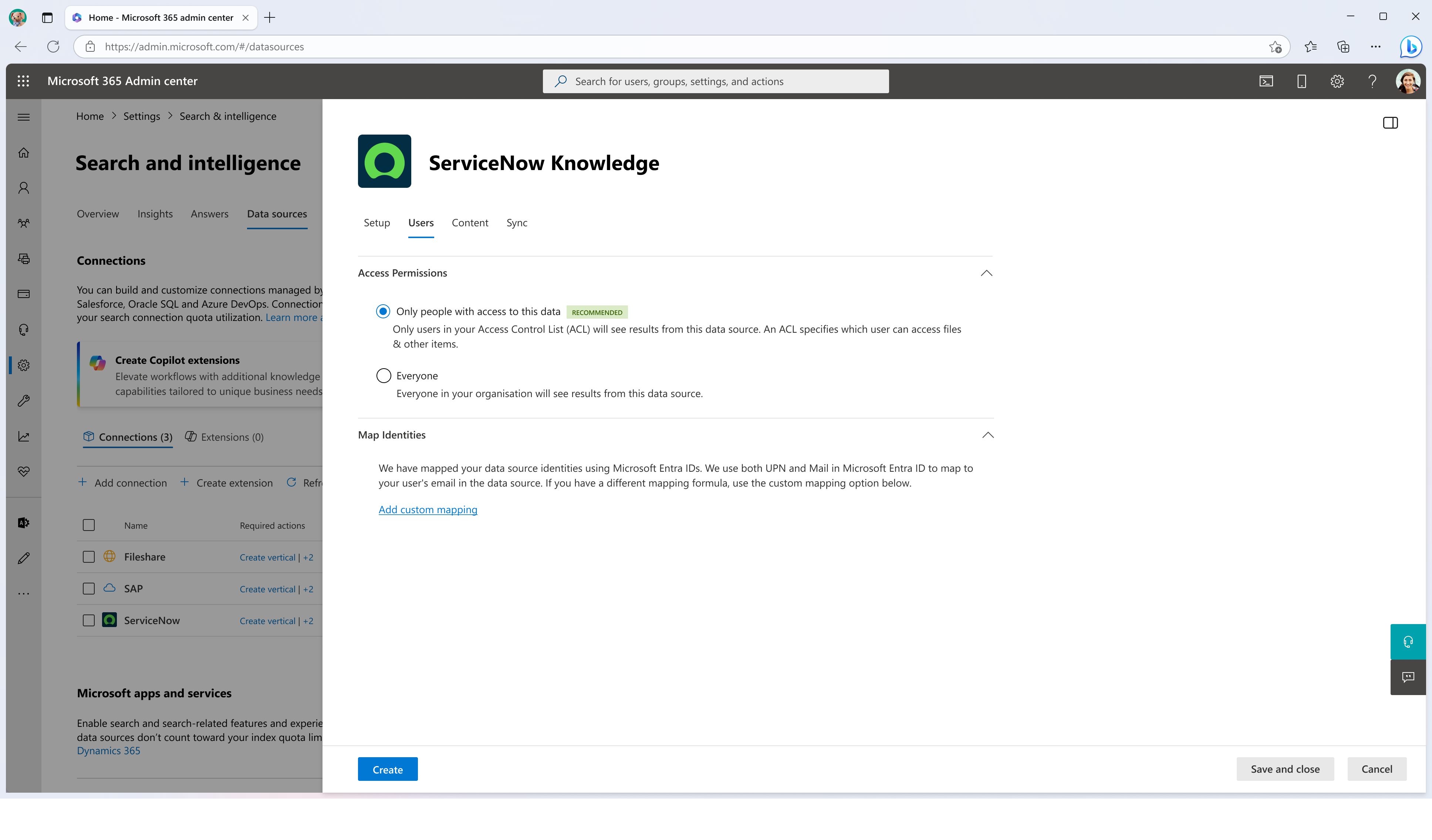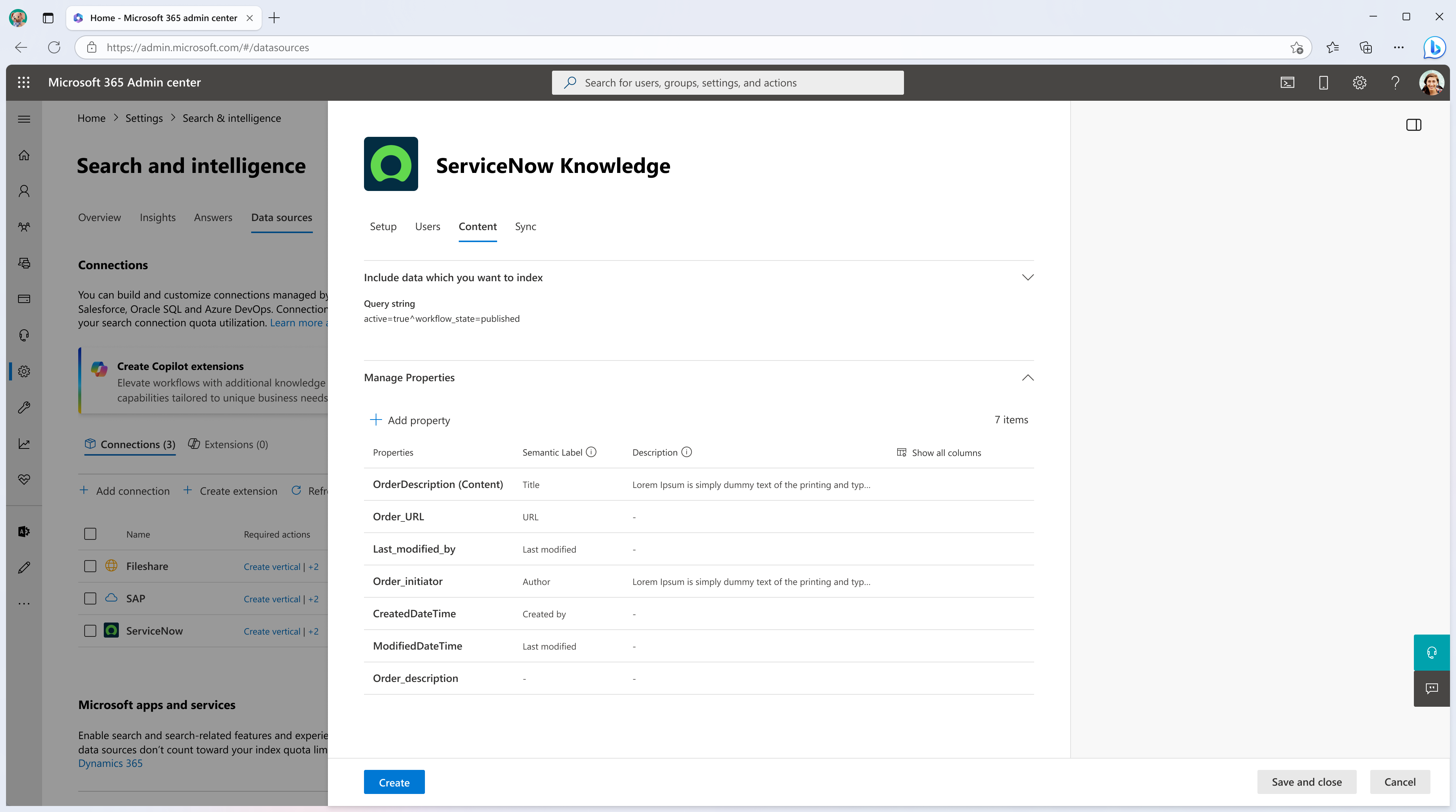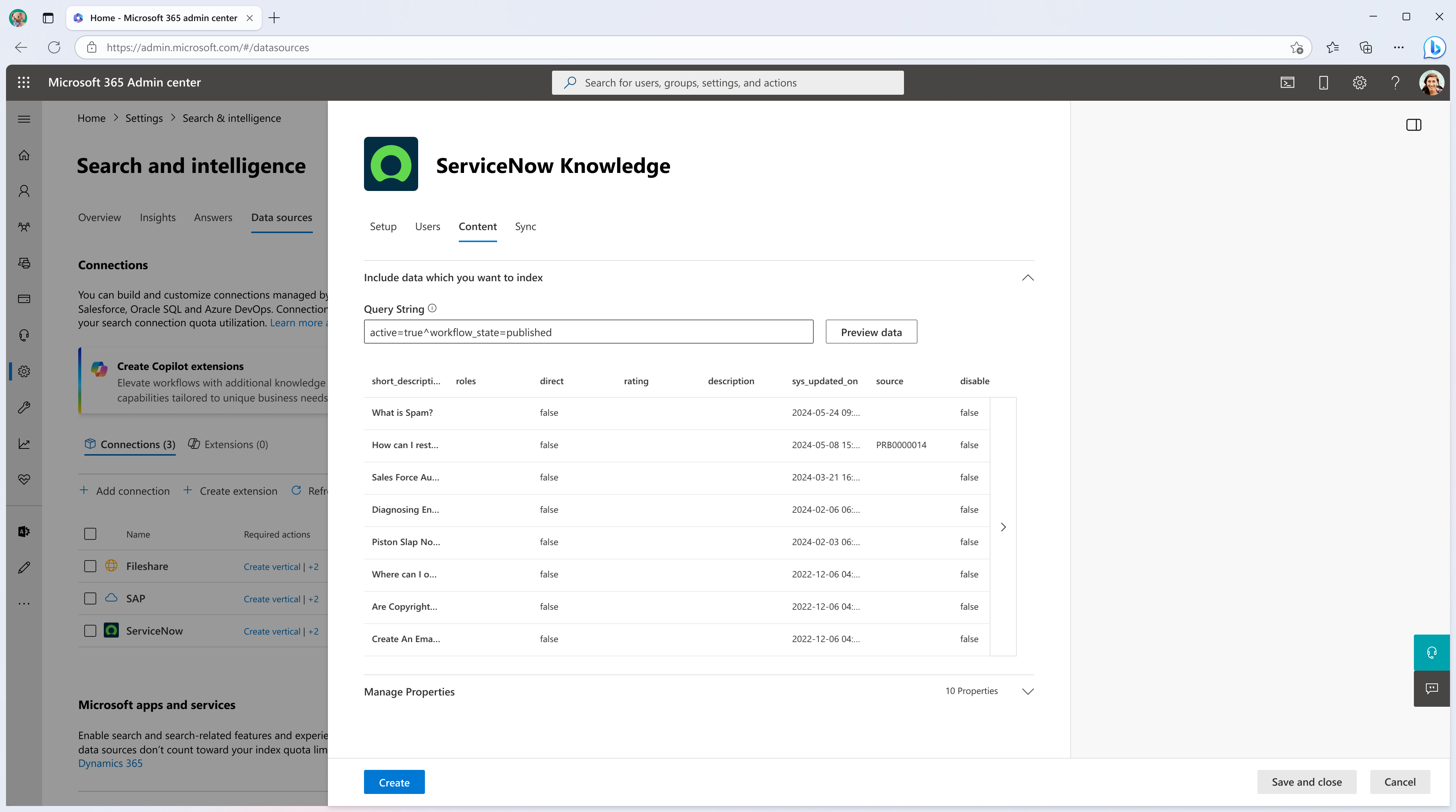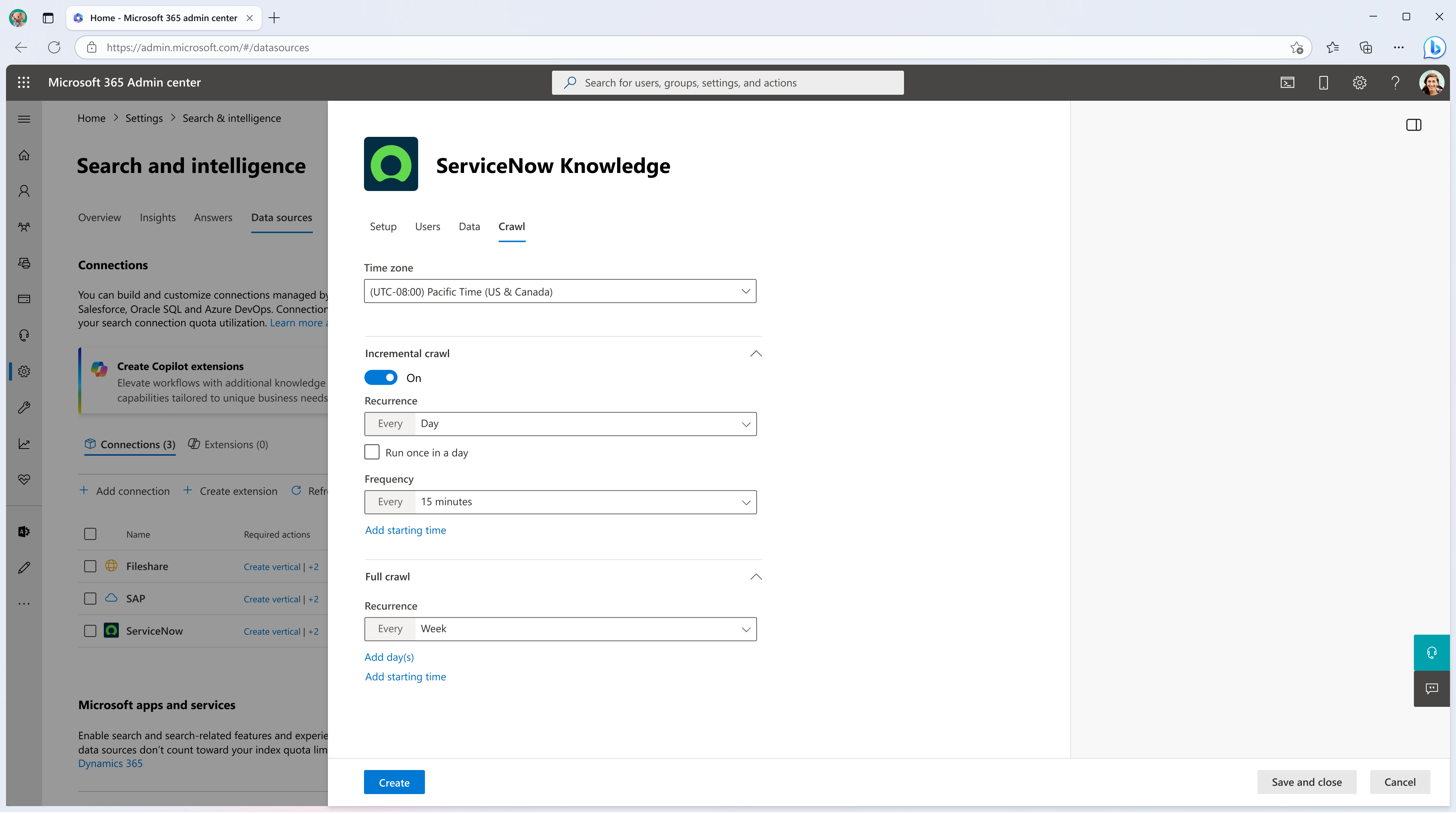ServiceNow Knowledge Microsoft Graph connector
With the ServiceNow Knowledge Microsoft Graph connector, your organization can index knowledge-base articles that are visible to all users or restricted with user criteria permissions within your organization. After you configure the connector and index content from ServiceNow, end users can search for those articles in Microsoft Copilot and from any Microsoft Search client.
This article is for Microsoft 365 administrators or anyone who configures, runs, and monitors a ServiceNow Knowledge Microsoft Graph connector.
Capabilities
- Index all types of knowledge articles
- Enable your end users to ask questions related to your IT/HR workflows in Copilot.
- How to request a new device?
- How to create a new VPN connection?
- How do I apply for leaves?
- Use Semantic search in Copilot to enable users to find relevant content based on keywords, personal preferences, and social connections.
Limitations
- Doesn't support Advanced scripts.
- If both Knowledge base and Knowledge article level permissions are defined, then only article-level permissions are honored.
- Does not index attachments.
Prerequisites
ServiceNow Instance URL: To connect to your ServiceNow data, you need your organization's ServiceNow instance URL. Your organization's ServiceNow instance URL typically looks like
https://your-organization-name.service-now.com. (Don’t have one? Check how to create a test instance)Service Account: To connect to ServiceNow and allow the ServiceNow Knowledge Microsoft Graph connector to update knowledge articles regularly, you need a service account with read access to specific ServiceNow table records. The service account needs read access to the following ServiceNow table records to successfully crawl various entities.
Feature Read access required tables Description Index knowledge articles available to Everyone kb_knowledge For crawling knowledge articles Index and support user criteria permissions kb_uc_can_read_mtom Who can read this knowledge base kb_uc_can_contribute_mtom Who can contribute to this knowledge base kb_uc_cannot_read_mtom Who cannot read this knowledge base kb_uc_cannot_contribute_mtom Who cannot contribute to this knowledge base sys_user Read user table sys_user_has_role Read role information of users sys_user_grmember Read group membership of users user_criteria Read user criteria permissions kb_knowledge_base Read knowledge base information sys_user_group Read user group segments sys_user_role Read user roles cmn_location Read location information cmn_department Read department information core_company Read company attributes Index extended table properties (optional) sys_db_object Read extended table details sys_dictionary Read extended table properties You can create and assign a role for the service account you use to connect with Microsoft Search. Learn how to assign role for ServiceNow accounts. Read access to the tables can be assigned on the created role. To learn about setting read access to table records, see Securing Table Records.
If you want to index properties from extended tables of kb_knowledge, provide read access to sys_dictionary and sys_db_object. Access to these tables is optional. You can index kb_knowledge table properties without access to the two additional tables.
Get started
This video provides a step-by-step guide on adding the ServiceNow Knowledge Microsoft Graph connector.
1. Display name
A display name is used to identify each reference in Copilot, helping users easily recognize the associated file or item. Display name also signifies trusted content. Display name is also used as a content source filter. A default value is present for this field, but you can customize it to a name that users in your organization recognize.
2. ServiceNow URL
To connect to your ServiceNow data, you need your organization's ServiceNow instance URL. Your organization's ServiceNow instance URL typically looks like https://your-organization-name.service-now.com.
3. Authentication type
To authenticate and sync content from ServiceNow, choose one of three supported methods:
Basic authentication
Enter the username and password of ServiceNow account with knowledge role to authenticate to your instance.
ServiceNow OAuth (recommended)
[Click to expand] To use the ServiceNow OAuth for authentication, follow these steps.
A ServiceNow admin needs to provision an endpoint in your ServiceNow instance, so that the ServiceNow Knowledge Microsoft Graph connector can access it. To learn more, see Create an endpoint for clients to access the instance in the ServiceNow documentation.
The following table provides guidance on how to fill out the endpoint creation form:
Field Description Recommended value Name Unique value that identifies the application that you require OAuth access for. Microsoft Search Client ID A read-only, auto-generated unique ID for the application. The instance uses the client ID when it requests an access token. NA Client secret With this shared secret string, the ServiceNow instance and Microsoft Search authorize communications with each other. Follow security best practices by treating the secret as a password. Redirect URL A required callback URL that the authorization server redirects to. For M365 Enterprise: https://gcs.office.com/v1.0/admin/oauth/callback,
For M365 Government: https://gcsgcc.office.com/v1.0/admin/oauth/callbackLogo URL A URL that contains the image for the application logo. NA Active Select the check box to make the application registry active. Set to active Refresh token lifespan The number of seconds that a refresh token is valid. By default, refresh tokens expire in 100 days (8,640,000 seconds). 31,536,000 (one year) Access token lifespan The number of seconds that an access token is valid. 43,200 (12 hours) Enter the client ID and client secret to connect to your instance. After connecting, use a ServiceNow account credential to authenticate permission to crawl. The account should at least have knowledge role. Refer to the table mentioned under the Service account in the Prerequisites section for providing read access to more ServiceNow table records and index user criteria permissions.
Microsoft Entra ID OpenID Connect
To use Microsoft Entra ID OpenID Connect for authentication, follow the steps below.
Register a new application in Microsoft Entra ID
To learn about registering a new application in Microsoft Entra ID, see Register an application. Select single tenant organizational directory. Redirect URI isn't needed. After registration, note down the Application (client) ID and Directory (tenant) ID.
Create a client secret
To learn about creating a client secret, see Creating a client secret. Take a note of client secret.
Retrieve Service Principal Object Identifier
Follow the steps to retrieve Service Principal Object Identifier
Run PowerShell.
Install Azure PowerShell using the following command.
Install-Module -Name Az -AllowClobber -Scope CurrentUserConnect to Azure.
Connect-AzAccountGet Service Principal Object Identifier.
Get-AzADServicePrincipal -ApplicationId "Application-ID"Replace "Application-ID" with Application (client) ID (without quotes) of the application you registered in step 1. Note the value of ID object from PowerShell output. It's the Service Principal ID.
Now you have all the information required from Azure portal. A quick summary of the information is given in the table below.
Property Description Directory ID (Tenant ID) Unique ID of the Microsoft Entra tenant, from step 3.a. Application ID (Client ID) Unique ID of the application registered in step 3.a. Client Secret The secret key of the application (from step 3.b). Treat it like a password. Service Principal ID An identity for the application running as a service. (from step 3.c)
Register the ServiceNow Application
The ServiceNow instance needs the following configuration:
Register a new OAuth OIDC entity. To learn, see Create an OAuth OIDC provider.
The following table provides guidance on how to fill out OIDC provider registration form:
Field Description Recommended Value Name A unique name that identifies the OAuth OIDC entity. Microsoft Entra ID Client ID The client ID of the application registered in the third-party OAuth OIDC server. The instance uses the client ID when requesting an access token. Application (Client) ID from step 3.a Client Secret The client secret of the application registered in the third-party OAuth OIDC server. Client Secret from step 3.b All other values can be default.
In the OIDC provider registration form, you need to add a new OIDC provider configuration. Select the search icon against OAuth OIDC Provider Configuration field to open the records of OIDC configurations. Select New.
The following table provides guidance on how to fill out OIDC provider configuration form:
Field Recommended Value OIDC Provider Microsoft Entra ID OIDC Metadata URL The URL must be in the form https://login.microsoftonline.com/<tenandId">/.well-known/openid-configuration
Replace "tenantID" with Directory (tenant) ID from step 3.a.OIDC Configuration Cache Life Span 120 Application Global User Claim sub User Field User ID Enable JTI claim verification Disabled Select Submit and update the OAuth OIDC Entity form.
Create a ServiceNow account.
Refer to the instructions to create a ServiceNow account, create a user in ServiceNow.
The following table provides guidance on how to fill out the ServiceNow user account registration
Field Recommended Value User ID Service Principal ID from step 3.c Web service access only Checked All other values can be left to default.
Enable Knowledge role for the ServiceNow account
Access the ServiceNow account you created with ServiceNow Principal ID as User ID and assign the knowledge role. Instructions to assigning a role to a ServiceNow account can be found here, assign a role to a user. Refer to the table mentioned under Service account in the Prerequisites section for providing read access to more ServiceNow table records and index user criteria permissions.
Use Application ID as Client ID (from step 3.1), and Client secret (from step 3.2) in admin center configuration wizard to authenticate to your ServiceNow instance using Microsoft Entra ID OpenID Connect.
4. Rollout to a limited audience
Deploy this connection to a limited user base if you want to validate it in Copilot and other Search surfaces before expanding the rollout to a broader audience. To know more about limited rollout, click here.
At this point, you are ready to create the connection for ServiceNow Knowledge. You can select the Create button and the ServiceNow Knowledge Microsoft Graph connector starts indexing articles from your ServiceNow account.
For other settings, like Access permissions, Data inclusion rules, Schema, and Crawl frequency, we have set defaults based on what works best with ServiceNow data. You can see the default values below:
| Users | |
|---|---|
| Access permissions | Only people with access to content in Data source. |
| Map Identities | Data source identities mapped using Microsoft Entra IDs. |
| Content | |
|---|---|
| Query String | active=true^workflow_state=published |
| Manage Properties | To check default properties and their schema, click here |
| Sync | |
|---|---|
| Incremental Crawl | Frequency: Every 15 mins |
| Full Crawl | Frequency: Every Day |
If you want to edit any of these values, you need to choose the Custom Setup option.
Get started with the ServiceNow Knowledge Microsoft Graph connector
Custom setup
Custom setup is for those admins who want to edit the default values for settings listed in the above table. Once you click Custom Setup, you see three more tabs: Users, Content, and Sync.
Users
Access permissions
The ServiceNow Knowledge Microsoft Graph connector supports access permissions visible to "Everyone" or "Only people with access to content in data source". Indexed data appears in results and is visible to all users in the organization or users who have access to them via user criteria permission respectively. Choose the one that is most appropriate for your organization.
If a knowledge article isn't enabled with a user criterion, it appears in the results of everyone in the organization.
Important
In ServiceNow, while assessing read permissions for a user, both article-level permissions and KB-level permissions are looked at. The ServiceNow Knowledge Microsoft Graph connector treats permissions differently:
If the article contains 'Can Read' user criteria, then they are stamped on the article during ingestion and Knowledge Base 'Can Read' / 'Can Contribute' user criteria are ignored.
If the article contains 'Cannot Read' user criteria, and if the corresponding Knowledge base also contains 'Cannot Read' user criteria, then both the user criteria are stamped on the article.
Note
If a user is part of the 'Can Read' user criteria at the article level but not in the 'Can Read' / 'Can Contribute' user criteria at the Knowledge Base level, then the user doesn't have access to the article in ServiceNow but does have access to the article in Microsoft Copilot, Microsoft Search, and other M365 surfaces. The workaround is to remove the user from the 'Can Read' user criteria at the article level.
Mapping identities
The default method for mapping your data source identities with Microsoft Entra ID is by checking whether the Email id of ServiceNow users is same as the UserPrincipalName (UPN), or Mail of the users in Microsoft Entra ID. If you believe the default mapping would not work for your organization, you can provide a custom mapping formula. To know more about, mapping Non-EntraID identities, click here.
Content
Query string
With a ServiceNow query string, you can specify conditions for syncing articles. It's like a Where clause in a SQL Select statement. For example, you can choose to index only articles that are published and active. To learn about creating your own query string, see Generate an encoded query string using a filter.
Manage properties
Here, you can add or remove available properties from your ServiceNow data source, assign a schema to the property (define whether a property is searchable, queryable, retrievable or refinable), change the semantic label, and add an alias to the property. Properties that are selected by default are listed below.
| Source Property | Label | Description | Schema |
|---|---|---|---|
| AccessURL | url | The target URL of the item in the data source | Retrieve |
| Active | |||
| ArticleType | |||
| Author | authors | Name all the people who participated/collaborated on the item in the data source | Search, Query, Retrieve |
| CanReadUserCriteria | |||
| CannotReadUserCriteria | |||
| Content | |||
| EntityType | |||
| IconURL | iconUrl | Icon URL that represents the article's category or type. | Retrieve |
| KbKnowledgeBase | |||
| Number | Retrieve | ||
| PreviewContent | Retrieve | ||
| Short_description | title | The title of the item that you want to be shown in Copilot and other search experiences | Search, Retrieve |
| SysCreatedBy | createdBy | Name of the person who created the item in the data source. | Retrieve |
| SysCreatedOn | CreatedDateTime | Data and time that the item was created in the data source | Retrieve |
| SysUpdatedBy | lastModifiedBy | Name of the person who most recently edited the item in the data source. | Retrieve |
| SysUpdatedOn | lastModifiedDateTime | Date and time the item was last modified in the data source. | Retrieve |
| WorkflowState | Retrieve |
Preview data
Use the preview results button to verify the sample values of the selected properties and query filter.
Sync
The refresh interval determines how often your data is synced between the data source and the ServiceNow Knowledge Microsoft Graph connector index. There are two types of refresh intervals – full crawl and incremental crawl. For more details, click here.
You can change the default values of the refresh interval from here if you want to.
Read and Deny Access to Knowledge Articles in the ServiceNow Knowledge Microsoft Graph connector
[Click to expand] Here is a scenario-wise depiction of how the connector treats access permissions based on user criteria in ServiceNow Knowledge:
Note
Terms used in the table below:
- No criteria: No user criteria are defined for the article or Knowledge base. (Different from empty criteria where a user criteria is defined but within the criteria all fields are empty)
- Default user criteria: User criteria defined using ServiceNow fields like Users, Groups, Roles, Location, Department, etc.
- Empty criteria: A User criteria where all fields have empty values.
How Read access is determined
| Knowledge Base | Knowledge Article | Access | |
|---|---|---|---|
| Can read | Can contribute | Can read | |
| Any criteria | Any criteria | Default user criteria | Default user criteria followed |
| Any criteria | Any criteria | Default + Advanced criteria | Default user criteria followed. Advanced criteria ignored. |
| Any criteria | Any criteria | Empty criteria + Any criteria | Access provided to every ServiceNow user |
| Default user criteria | Default user criteria | No criteria | Default user criteria followed. [Note: If the 'Cannot Contribute' user criteria is not present, then default criteria from both 'Can read' and 'Can Contribute' are followed. But if the 'Cannot Contribute' user criteria is present, then 'Can Contribute' user criteria is not stamped.] |
| Default + Advanced criteria | Default + Advanced criteria | No criteria | Default user criteria followed. Advanced criteria ignored. |
| Empty criteria | Any criteria | No criteria | Access provided to every ServiceNow user |
How Deny access is determined
| Knowledge Base | Knowledge Article | Access |
|---|---|---|
| Cannot read | Cannot read | |
| Default user criteria | Default user criteria | Both criteria at base and article level are honored. |
| Advanced criteria | Any criteria | Deny access to everyone. |
| Any criteria | Advanced criteria | Deny access to everyone. |
| Empty criteria + Default user criteria | Any criteria | Deny access to everyone. |
| Any criteria | Empty criteria | Deny access to everyone. |
Troubleshooting
After publishing your connection, you can review the status under the Data sources tab in the admin center. To learn how to make updates and deletions, see Manage your connector. You can find troubleshooting steps for commonly seen issues here: Troubleshooting the ServiceNow Knowledge Microsoft Graph connector.
If you have issues or want to provide feedback, contact Microsoft Graph | Support.



